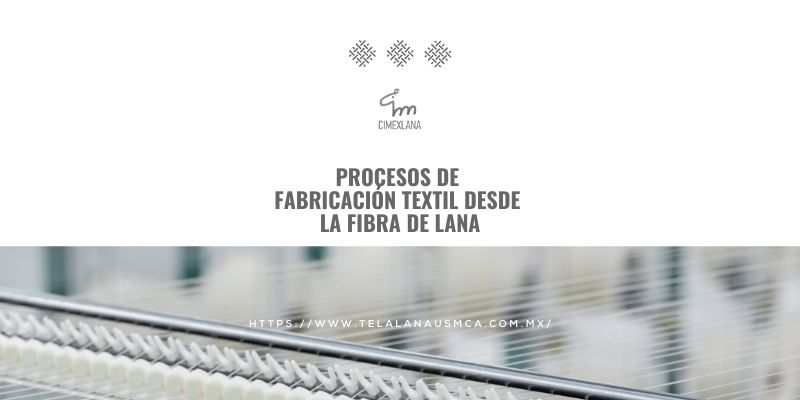
Textile Manufacturing Processes from Wool Fiber
The textile production of wool fabrics Wool is an ancient and complex art that combines tradition, innovation, and modern techniques to transform fibers into final products. From harvesting wool to creating a garment or decorative fabric, the different stages of this process are essential to ensuring quality, durability, and sustainability. In this article, we'll review the key phases of wool textile production step by step to demystify this fascinating process.
If you've ever wondered what it takes to turn raw wool into something you can use in your everyday life, this tour will give you a complete and clear understanding.
Where wool comes from
Before delving into the technical details, it's important to understand the origin of the fiber. Wool is obtained from animals such as sheep, llamas, alpacas, and vicuñas. The quality of wool varies considerably depending on the species and the environment in which the animal lives. For example:
- Merino: Recognized for its softness, it is one of the finest and most appreciated fibers.
- Llama and alpaca: More robust fibers with excellent thermal properties.
- Cashmere: Obtained from certain breeds of goats, it is highly valued for its luxury and comfort.
This diversity of fibers defines the characteristics of the final products.
Main stages in wool textile manufacturing
1. Esquilado
The process begins with the collection of wool, known as "shearing."
- How is it done? The fleece of the animals is cut with special tools, ensuring that the animal is not harmed.
- Purpose: We obtain raw wool that will be processed to remove impurities such as grease, dirt, and organic matter.
For each shorn animal, between 2 and 8 kilograms of wool are produced per year, depending on the species and size.
2. Washing the wool
After shearing, the wool undergoes intensive washing to remove dirt, natural grease (lanolin) and other contaminants.
- Process: The fibers are immersed in hot water baths with specialized detergents.
- Benefit: This step ensures that the fiber is clean and ready to be processed in the following stages.
In addition, many manufacturers use the lanolin extracted during washing for cosmetic and pharmaceutical products.
3. Carded
The next step is thecarded, which consists of untangling and aligning the wool fibers.
- How does it work? The wool is passed through machines equipped with cylinders covered with spikes that separate and arrange the fibers.
- Purpose: This procedure is to remove plant fibers and begins with the preparation of the wool, passing it from the rough to layers of wool called "laps" and finally to wool cables known as rovings.
4. Preparation
In this process, the wool goes through a series of machines that comb the wool and transform it from a wick into a thinner wire called a wick, and then it is ready for the next process.
5. Spinning
The wool wick is transformed into threads on spinning machines.
- Technical details: The wool is stretched and twisted to create a strong, uniform yarn.
- Adaptability: Depending on the thickness and twist level, the yarns can be used for various types of knitting, from thick sweaters to delicate scarves.
During spinning, the fibers may be mixed with other materials, such as silk and flax, or synthetic fibers, to modify their properties.
6. Dyeing
With the yarn produced, it's time to add color.
- Common techniques:
- Dyeing in Tops (on wool cables)
- Skein dyed (the yarns are dyed together).
- Piece dyeing (the already woven product is dyed).
- Environmental Considerations: Today, many manufacturers use eco-friendly dyes that minimize environmental impact and improve the sustainability of textile production.
Dyeing contributes to the diversity of styles and appearance offered by the final products.
7. Fabric or clothing
The final stage involves the creation of finished products through weaving or sewing processes.
- Flat fabrics: Used for garments such as suits or decorative materials.
- Knitted fabrics: More elastic, perfect for sweaters or casual wear.
Modern machines and computerized patterns allow for precise and detailed finishes, bringing complex designs to life.
Benefits and qualities of wool products
Why does wool remain such a prized material, even in a market full of synthetic options? Here are some reasons:
- Thermal versatility: Wool acts as a natural insulator, keeping you warm in winter and cool in summer.
- Durability: Well cared for, a wool garment can last for decades.
- Biodegradable: Unlike synthetic fibers, wool is completely natural and decomposes under appropriate conditions without producing pollution.
- Comfort: It is soft to the touch and naturally stretchy, making it very comfortable for everyday wear.
How to choose quality wool products
When looking for wool products, keep these key points in mind to ensure a good investment:
- Origin of fiber: Choose certified products from regions recognized for their good livestock practices.
- Composition label: The purity of the wool (without synthetic blends) is ideal for maintaining its natural properties.
- Finish: Check the texture; it should be smooth, without irregularities or rough areas.
Buying wool products not only means holding an incredibly functional material; you're also connecting with a legacy of traditional techniques and sustainability.
Enjoy wool products in your daily life
The journey of wool fiber from the grasslands to your clothing or home textiles is a testament to human skill and innovation. With processes that respect both tradition and the environment, wool continues to hold a prominent place in the textile industry.
If this article sparked your interest in the incredible benefits of wool, explore further and start incorporating superior clothing and fabrics into your life. The next time you wrap up in a wool sweater or relax on a woven rug, you'll know all the work that goes into its creation!

